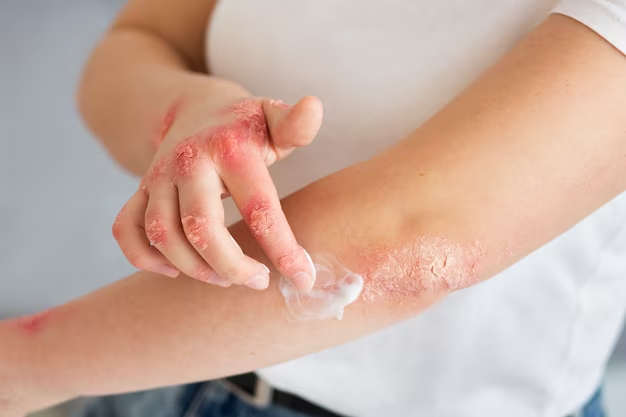
Overview
What is eczema?
- Definition: A condition causing dry, itchy, and bumpy skin.
- Impact: Weakens skin’s barrier function, leading to moisture loss and increased sensitivity.
- Type: Dermatitis, a group of conditions causing skin inflammation.
- Contagious?: No, eczema is not contagious.
Types of eczema
- Atopic dermatitis
- Contact dermatitis
- Dyshidrotic eczema
- Neurodermatitis
- Nummular eczema
- Seborrheic dermatitis
Who is affected?
- Anyone at any age
- Higher risk: Family history of dermatitis, allergies, hay fever, asthma.
Prevalence
- Common: Over 31 million Americans affected.
- Infants: 10-20% have eczema; nearly half outgrow it.
Causes
- Triggers: Environmental irritants or allergens.
Symptoms and Causes
Symptoms
- General: Dry, itchy skin, rash, bumps, thick patches, flaky/scaly skin, swelling.
- Appearance:
- Dark skin: Purple, brown, or gray rashes.
- Light skin: Pink, red, or purple rashes.
- Common areas: Hands, neck, elbows, ankles, knees, feet, face, ears, lips, nipples, breasts, vulva, penis.
Pain
- Generally not painful unless scratched, leading to sores.
Causes
- Immune system: Overreacts to small irritants/allergens, causing inflammation.
- Genetics: Family history of eczema, asthma, hay fever, allergies.
- Environment: Smoke, pollutants, soaps, fabrics, low humidity, heat.
- Emotional triggers: Stress, anxiety, depression.
Triggers
- Dry weather, fabrics, skin care products, smoke, pollutants, soaps, stress, allergens.
Food allergies
- Common triggers: Peanuts, dairy, eggs.
- Note: Not all foods cause eczema; individual response varies.
Autoimmune status
- Not classified as an autoimmune disease.
Diagnosis and Tests
Diagnosis
- Method: Physical exam by healthcare provider.
- Common in: Children, but can be diagnosed at any age.
Tests
- To confirm diagnosis and rule out other conditions:
- Allergy test.
- Blood tests.
- Skin biopsy.
Questions by provider
- Location and duration of symptoms.
- Use of products.
- Medical history (allergies, asthma, family history).
- Triggers and worsening factors.
Specialists
- Dermatologist for diagnosis and treatment.
Management and Treatment
Treatment steps
- Moisturize: Use gentle/sensitive skin moisturizers frequently.
- Topical medications: Steroids and other prescribed creams.
- Oral medications: Anti-inflammatory, antihistamines, corticosteroids.
- Immunosuppressants: To regulate immune system.
- Light therapy: Improves skin appearance.
- Avoid triggers: To prevent flare-ups.
Childhood eczema
- Bathing: Short, warm baths.
- Moisturizing: Frequently, especially after baths.
- Clothing: Cotton preferred, avoid wool and synthetic fabrics.
- Detergent: Use sensitive or unscented.
- Scratching: Minimize to prevent skin damage.
Types of moisturizers
- Characteristics: Hypoallergenic, fragrance-free, dye-free, gentle, petroleum jelly or mineral oil based, preservative-free, lipid and ceramide enriched.
Managing symptoms
- Avoiding triggers: Environmental and emotional.
- Treatment adherence: Follow healthcare provider’s instructions.
Recovery time
- Variable: Could take weeks for skin to clear; contact provider if no improvement.
Complications
- Weeping eczema: Fluid-filled blisters.
- Infected eczema: Bacterial, fungal, or viral infections.
Prevention
Steps to prevent flare-ups
- Moisturize: Regularly, especially after baths/showers.
- Water temperature: Use warm, not hot.
- Hydration: Drink plenty of water.
- Clothing: Wear loose, natural fibers like cotton.
- Stress management: Address emotional triggers.
- Humidifier: Use in dry environments.
- Avoid irritants: Identify and steer clear of known triggers.
Outlook / Prognosis
Expectations
- Non-lethal: Not harmful to the rest of the body.
- Children: Many outgrow it by puberty.
- Adults: Manageable with proper care.
Duration
- Chronic: Lifelong condition, manageable with treatments.
Cure
- None: Treatments available but no complete cure.
Living With
Self-care
- Management: Avoid triggers, moisturize, take medications, follow provider’s advice.
- Flare-ups: Manageable with proper care.
When to see a provider
- Symptoms: Presence of eczema symptoms.
- Worsening: Symptoms worsen after treatment.
- Persistent: Symptoms don’t clear after a few weeks.
- Infection signs: Fever, pain, fluid-filled blisters.
Questions for provider
- Differential diagnosis.
- Recommended moisturizers.
- Treatment side effects.
- Frequency of dermatologist visits.
- Products to avoid.
- Home care advice.
Additional Common Questions
Weather impact
- Effect: Both low humidity and high heat/humidity can worsen eczema symptoms.
Skin : The Body’s Largest Organ. What’s the importance of skin
